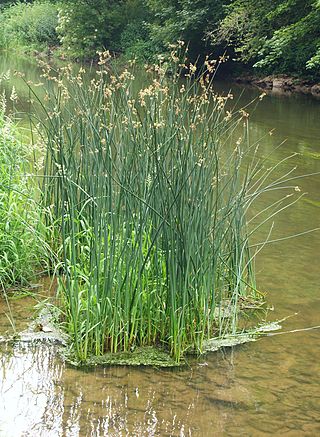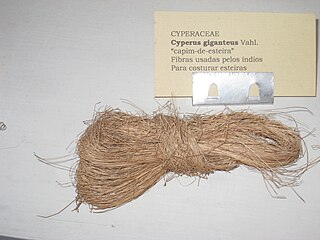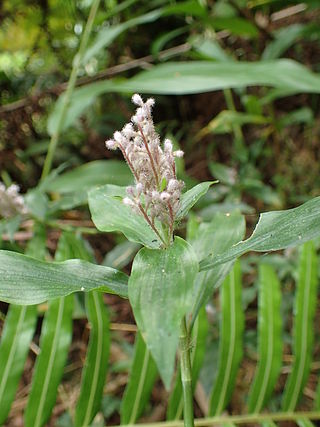
Cyperus is a large genus of about 700 species of sedges, distributed throughout all continents in both tropical and temperate regions.

Furcraea foetida is a species of flowering plant native to the Caribbean and northern South America. It is widely cultivated and reportedly naturalized in many places

Schoenoplectus is a genus of plants in the sedges with a cosmopolitan distribution. Note that the name bulrush is also applied to species in the unrelated genus Typha as well as to other sedges. The genus Schoenoplectus was formerly considered part of Scirpus, but recent phylogenetic data shows that they are not closely related.

Rauvolfia is a genus of evergreen trees and shrubs, commonly known as devil peppers, in the family Apocynaceae. The genus is named to honor Leonhard Rauwolf. The genus can mainly be found in tropical regions of Africa, Asia, Latin America, and various oceanic islands.
Shirakiopsis is a genus of flowering plants in the family Euphorbiaceae first described as a genus in 1999. There are six known species, 3 native to tropical Asia and 3 to tropical Africa.

Drypetes is a plant genus of the family Putranjivaceae, in the order Malpighiales.

Cenchrus is a widespread genus of plants in the grass family. Its species are native to many countries in Asia, Africa, Australia, the Americas, and various oceanic islands.

Najas, the water-nymphs or naiads, is a genus of aquatic plants. It is cosmopolitan in distribution, first described for modern science by Linnaeus in 1753. Until 1997, it was rarely placed in the Hydrocharitaceae, and was often taken as constituting the family Najadaceae.

Cyperus giganteus is a perennial herbaceous plant. It belongs to the genus Cyperus. Its native range extends from Jalisco in west-central Mexico as far south as Uruguay, and also grows on some islands in the Caribbean. The species is sparingly naturalized in eastern Texas and southern Louisiana.

Cyperus haspan is a dwarf papyrus sedge in the Cyperaceae. It is widely distributed in tropical and subtropical regions in Africa, Madagascar, southern Asia, New Guinea, Australia, South America, West Indies, Central America, southern Mexico and the southeastern United States.

Aneilema is a genus of monocotyledonous plants of approximately 60 species. The vast majority of the species are native to sub-Saharan Africa, but a few are found in Oceania and one, Aneilema brasiliense, is from South America. It is the third largest genus in the family Commelinaceae after Commelina and Tradescantia, and it is one of only six genera in the family to occur in both the Eastern Hemisphere and the Western Hemisphere.

Floscopa is a genus of plants in the family Commelinaceae first described in 1790. It is widespread in tropical and subtropical areas: Africa, Madagascar, the Indian Subcontinent, Southeast Asia, China, Queensland, Central + South America.

Cyperus laevigatus is a species of sedge known by the common name smooth flatsedge.

Lipocarpha is a genus of sedges known as halfchaff sedges. There are approximately 35 species and representatives can be found throughout the tropical and warmer temperate areas of Africa, Asia, Australia, North America, South America and various oceanic islands. These mostly are erect annual herbs growing 1 to 30 centimeters tall. The inflorescence consists of one to few spikes each containing many spirally arranged spikelets. The flower is entangled with two hyalin scales, a spikelet prophyll and a glume. These flower stands in the axil of a spikelet-bract.

Barleria prionitis is a shrub in the family Acanthaceae, native to Island and Mainland Southeast Asia, China, the Indian Subcontinent, the Arabian Peninsula and northeastern Africa. It is widely spread as an ornamental and weed, occurring in naturalised populations around the world. It used not only as an ornamental but also as a hedge and extensively as a component of folk medicines. As a weed it is regarded as problematic in many areas.

Murdannia is a genus of annual or perennial monocotyledonous flowering plants in the family Commelinaceae.

Myxopyrum is a plant genus native to India, southern China, Southeast Asia and New Guinea. There are at present 4 recognized species:

Diodella is a genus of flowering plants in the family Rubiaceae. The genus has a wide distribution range and is found from the USA to tropical America and in tropical Africa.

Spermacoce alata, the winged false buttonweed, is a species of plant in the Rubiaceae. It is widespread across the warmer parts of the Western Hemisphere and naturalized in many other parts of the world.
Cyperus dubius, the soft sedge, is one of around 700 species of Cyperus in the sedge family, Cyperaceae. It is found throughout in tropical Africa, South India, and Indo-China to Malesia. It grows in seasonally flooded areas and in pockets of soil among rocks. It is not confined to wetlands and is sometimes found as a weed in fields, near the sea on sandy beaches and also seen in open shady places.

















